
It was hot and steamy.
The dim sum and the night spent with Taste of Thailand Food Tours exploring Bangkok’s Chinatown.
Thailand is home to the largest and most integrated Chinese community in the world and Bangkok’s Chinatown is one of world’s largest and oldest. In fact, the Chinese population makes up 14% of Thailand’s nine million population and Thais who have an Chinese ancestry account for additional 12% of the population.
It is now reaching the hot season in Bangkok where the temperature regularly tops 40° C (105° F) and rarely drops below 25° C (77° F) ever. Having lived through winters in Ottawa, Canada where it can reach -40° C (-40° F) on the coldest days, I’m not sure which is worse.
Dim sum means ‘touch the heart’ in Chinese
The stop at The Canton House restaurant was well timed by our guide Thee and a welcome relief in many ways. After several stops at tasty spots, it was the ideal time to come inside to an air conditioned restaurant, use the washrooms, sit down and share tasty bites of dim sum over iced jasmine tea and cold Singha beer for some.
Thee explained that Dim Sum started with the act of drinking tea. Thousands of years ago tea houses popped up to serve people traveling along the ancient Silk Road through China. The tea houses began offering bite-sized plates as an accompaniment to the tea.
The small portions were originally designed to merely touch the heart and not fill you up. They are usually served in small steamer baskets or plates and brought to you by servers or women pushing carts with stacks of steamer baskets, the latter harder to find here.

pak boon, Chinese water morning glory
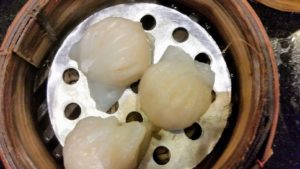
har gow, steamed shrimp dumplings
The best street food in the world
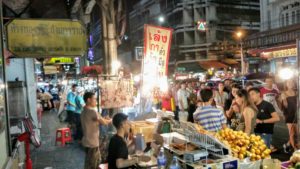

As we moved between spots, the streets of Chinatown was packed with street food vendors and people. I asked Thee if this was normal and he nodded saying, “it’s like this every night.”
In some cities, they “roll up the sidewalks at night”, here the sidewalks roll out at night and eager locals and tourists come out to try some of the best street food in the world.
Taste of Thailand Food Tours promotes “real food” and “real people”. Their tours live up to this in spades. This is my second tour with them, the first one I took with them to Bangrak and loved. I loved this one too, but in a different way.
First of all, the “Chinatown Food Crawl” as they call it is at night so this changes the mood, there are more stops, around 12 in all, and they are diverse to give you different “flavours” of the local food scene in Chinatown.
Local guide, local spots, local food

Our guide Thee with another guide Bella
What I really loved about the tour is how the guide is like your good friend that knows the area and good food and takes you to his favourite spots. This is not a cookie cutter tour with large groups going to places that only tourists and foreigners go to. You go where they like to go and locals frequent, and thus the group sizes are kept small and intimate.
Not only does Thee have to lead groups through the Chinatown maze in the heat, but he also has to organize tables and chairs at each popular spot upon arrival and chat with chefs and staff so that we are fed and served relatively quickly during a busy service. This is no easy feat but he did it with ease and grace so we seemed to move seamlessly from one spot to another, along with our appetites and curiousity to try more local food.
One woman makes one of the best street food dishes in Bangkok

Packed patio outside Nai Mong restaurant
Case in point. Thee led us to a very busy restaurant called Nai Mong where the patio was packed and he worked with staff to organize some tables and chairs inside for us and drinks while we waited for our food.
A lot of the kitchens here are almost like street stands in that they are either outside the restaurant or right inside the dining room, with no air conditioning of course. A woman chef was standing in front of a very large wok cooking up big batches of hoi tod, which is a crispy Thai style omelette with oysters or mussels.
Thee said the woman chef is the wife of the husband whose family who owns the restaurant. I saw the husband taking customer orders and serving, his mother helping to plate the dishes, and their children helping in the back kitchen prepping. This is definitely a family affair of many generations helping to get through a very busy service.
The dish came and it was delicious. Crispy pieces of omelette on the bottom with fresh barely cooked oysters on top, served with a sweet chili sauce on the side.

Hoi tod, crispy omelette with oysters
I told the woman chef as I was leaving “thank you” and “it’s very delicious” in my limited Thai. She smiled at me.
I wish I could tell her how much I truly appreciate that she gives everything she has to cook all night, every night, in front of a hot wok on typically hot and steamy Bangkok nights and packed houses.
Perhaps her reward is being known as one of the best places in town to eat hoi tod. In fact CNN names the food stall one of the top 10 in Bangkok you must try. Even as I write this I crave to try this dish again. It is indeed a taste memory.
I could have eaten more at every stop and that’s why it’s great to have a guide to monitor what and how much you eat. It is a careful orchestration of an evening like a chef does with a tasting menu, except this one is done in different spots all over the crazy busy packed Chinatown area.
Mr. X marks a great spot for soup

All generations eating soup and noodles at Mr. X
By the time we ended up at Mr. X, a very popular noodle spot on the main strip, I was getting quite full so I just wanted a taste of the popular flat noodles in soup. But when I tried the soup, I couldn’t stop from taking tastes until I had finished almost the whole bowl!
That’s what I love about great food. It grabs your attention and you can’t stop eating it.
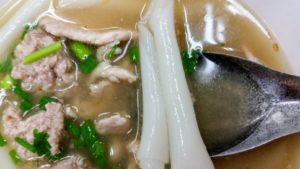
Peppery broth and rolled noodles at Mr. X
The broth had a blend of special spices, like five spice ingredients, that hit me in the back of the mouth with a tingly peppery feeling on your tongue, not the “pow” that you get in the front of your mouth from chili peppers. The soup was served with freshly made noodles that go from flat to round when boiled and are velvety smooth.
With good food, it may seem simple but I know there is often a lot of thoughtfulness, complexity and hard work that has gone in it.
Again here, the rustic kitchen area is out in the dining room with the tables and chairs around. A huge pot of simmering broth, fresh ingredients all around it, piles of soup bowls, and the cooks quickly preparing the different soup dishes to order.
This is fast food but not in the North American sense. Food is made and brought to you quickly and you leave as soon as you’re done to make space for people in the long line-up who are eager to try their dishes too.
Drinking your dessert
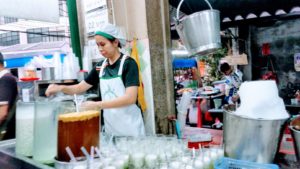
Lod Chong main area for serving desserts and drinks
The local Thais love their drinks, desserts, and sometimes you can get your dessert and drink in one glass. We stopped at a place called Lod Chong that is famous for its traditional Thai dessert called singapo. They also serve some food as well. Glasses are filled with coconut milk and tapioca flour chewy noodles flavoured with pandan juice and crushed ice goes in last.

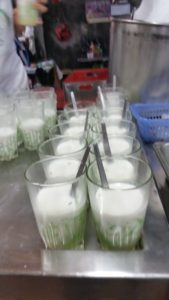
Pandan is a herbaceous tropical plant that grows in Southeast-Asia. It’s bright green leaves are used for cooking many Thai dishes to impart a sweet aroma and flavour, in particular with drinks and desserts. Some call it the vanilla of South-east Asia.
The drink was delicious but then again I am a big fan of bubble tea and grass jelly in my drinks. They say that they don’t get a lot of foreigners visiting and their clientele is mostly Thai but that’s why I like the place, it’s local and I long to slurp the dessert drink again.

Caroline and the chef of Singapo
Drinking your medicine
We stopped at a 115-year-old teashop called Khang Ki, which serves two iced teas, one a chrysanthemum tea and the other a 10 Chinese herbs drink called nam kom that the Thai-Chinese people drink to cure sore throats, fevers, canker sores, and more. One sweet the other bitter.

Khang Ki, left Chrysanthem tea, right 10 Chinese herbs drink
I could only take a few sips of the bitter one and had to stop. If you’ve ever had Chinese medicine and herbs, you’ll know what it could taste like and I need to say no more. It’s good for you, and it doesn’t taste good. Apparently the bitter taste is very good for us and we’re not used to it, especially in the North American culture, so when we do have bitter it’s often covered up with sugar. Here it’s just the very bitter.
There was one brave soul in our group that downed the whole thing like a shooter because he wanted to get rid of the cold he had and he hoped it would help.
Unholy donuts served here
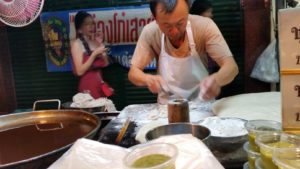
Cook rolling out dough for donuts

Vendor packing up donuts and cream for us
We gathered around Thee to eat donuts without the hole with delicious pandan cream at a street vendor called Pathongko. These were freshly made-to-order donuts with a cook using using part of the street cart to roll out the doll, cut it, and then put it immediately in the large wok of hot oil beside him. Unanimous yum to these!
Sweet or salty desserts

Bae Sun Li bakery, Chinatown Bangkok

Sweet and salty cakes at Bae Sun Li bakery in Chinatown
We went into Bae Sun Li, a Chinese bakery filled with traditional pastries, many with the family emblem on them. We were given two traditional Chinese pastries to try, one salty the other sweet.
I find Chinese desserts not very sweet, sometimes savoury, and often sweet and savoury combined. This makes sense as desserts in China are different from the West. There is often not the tradition of different courses when you’re having dinner at a restaurant and instead dishes come when they’re ready, including dessert type dishes, and are shared.
The ultimate crowd pleaser
We stopped in front of the street stall of a woman who locals say has the best mango sticky rice (khaoniao mamuang), or with durian if you prefer. She calmly peeled the mangos and cut the slices for each order so they were at their best, and they were. Perfectly ripe and sweet, the mangos were served with a warm sticky rice with coconut. This was definitely a crowd pleaser!
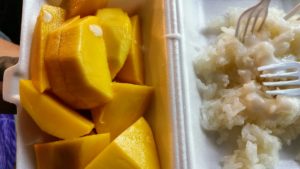
khaoniao mamuang, mango sticky rice
Sweet time for ginger tea and rice dumplings
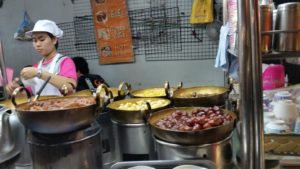
Sweet Time desserts and tea in Bangkok’s Chinatown
A perfect end to the evening and a tummy settler after eating our way through Chinatown was a cool ginger tea. Actually the tea came in a bowl and was a like a sweet ginger soup with small rice dumplings like mochi, called tangyuan, stuffed with a sesame paste. I could barely finish this but having a mochi addiction and loving ginger I pursued.

Ginger soup with rice dumplings with sesame
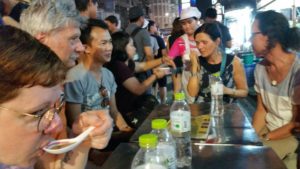
Eating cold soup/tea in Bangkok’s Chinatown
The street vendor Sweet Time set up folding tables and stools for us on the sidewalk so we could have our tea/soup. I love how tables are set up as people need them to eat right by the street vendor of their choice.
It was noisy, it was hot, it was crowded, it was bright from the neon street signs, and the street food vendors around us were interacting with customers over one of the most important currencies in the world… food made with love. It is no wonder CNN has named Bangkok as having the best street food in the world two years running.
Dry ice, women and ice cream on main street
As we were drinking our ginger teas and soaking up the ambiance on Yaowarat Road, I noticed two young women in a stall near us creating quite the buzz on the street. They were like bartenders in a hot night club but instead of serving cocktails it was ice cream!
One woman would scoop out ice cream balls from a drum filled with dry ice so there was a lot of smoke around the bowl. She would pass this bowl with ice cream and smoke to the other woman who would pour the sauce over it like she was making a cocktail. Take that Tom Cruise (in the movie Cocktail)! Needless to say, there were a lot of selfies and sales at this stall. This too is Chinatown at night.
Two thumps up!
Thank you Taste of Thailand Food Tours, Thee and my fellow tour companions who made this a tour an experience not to be missed when in Bangkok.

Chinatown with Taste of Thailand Food Tours
7 tips if you’re going on the tour
- Bring your appetite. You should come on an empty stomach.
- Ideally you are a food lover and curious soul who is willing to try ingredients and dishes that you’ve never tried in the way the chef wants you too. That is the purpose of a food tour after all isn’t it?You might not like some things, but you also might fall in love with some things. You never know.
- Be prepared to walk through packed streets in the heat so good shoes and cool clothes will help you with this. The tour will provide you with some bottled water but you might want to bring some more and napkins for wiping your face and fingers from all the bites you will be tasting on the street.
- Please tell the tour beforehand about your dietary restrictions and allergies and they will try to accommodate you.
- Thank your guide at the end and express your appreciation with a tip, which is not required but always welcome and greatly appreciated.
- If you’ve enjoyed the tour, the best thank you for a tour operator like Taste of Thailand Food Tours is to write a review on Trip Advisor. We live in a world where travelers base their choices of travel and tours on online reviews from customers and tour operators are dependent on these reviews for their survival.
- Have fun and create some new taste memories to take back home!
Also published on Medium.


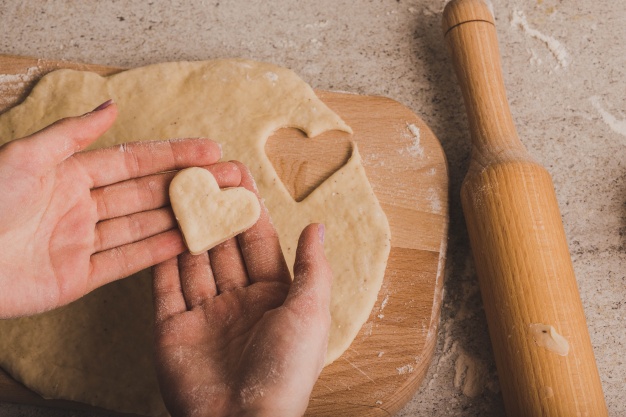

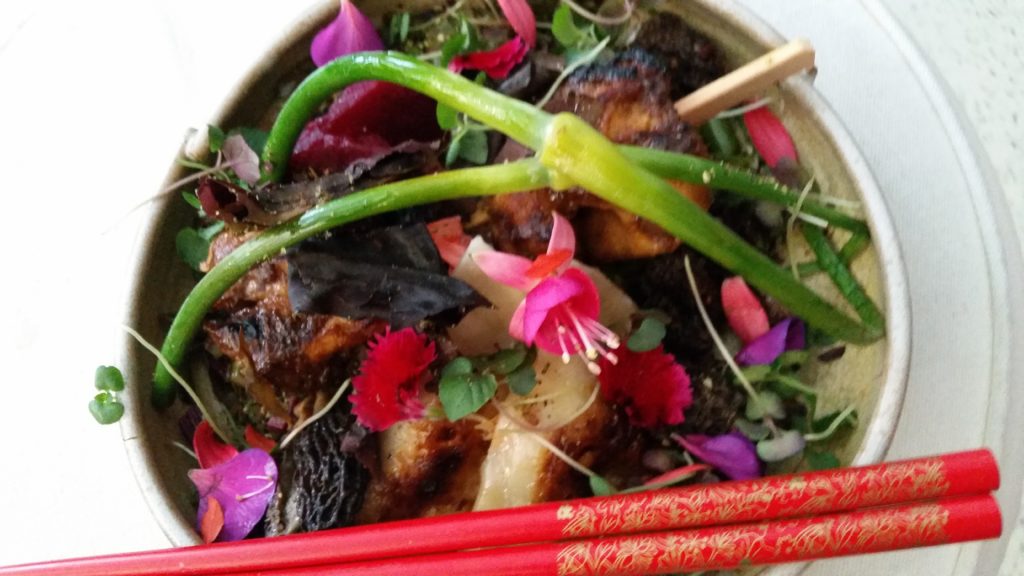


0 Comments